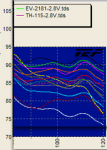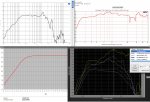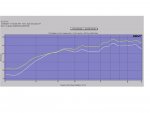While trying to compare hundreds of sub response curves, it seems that half space curves using TEF analyzers often show levels about 3-5 dB higher than other test systems and simulations read.
I have attempted to show the difference in the screen capture below.
The JBL SRX728 comes in “par for the course” when comparing decent dual 18” bass reflex cabinets of similar size, other than the usual “see saw” effect, speakers with lighter cones and higher tunings will be more sensitive up high, speakers with more LF output are less sensitive.
Previously there has been speculation that JBL was using full space for measuring their subs, which would account for a 6 dB difference, but that has been proven not to be the case.
The JBL SRX728 published chart shows about 100 dB 1 watt one meter at 120 Hz.
Comparing the chart next to it, a BFM condensed version of the 2006&7 Tulsa sub shootout, the 728 reads about 3 dB higher than it does on the JBL chart.
Looking at the response of the JTR Growlerx2, by reducing 6 dB (+3 double cabs, +3 double power) we see a single should be within a dB at 60 to 70 Hz as the 728, about 97.5 dB.
The chart above from the 2007 NYC sub shootout shows a single JTR Growler at about 105 dB, the DSL TH-215 just under that level at that frequency.
The DSL published chart for the TH-115 shows the level to be around 102.5 dB in that range, by inference that may be 5 dB higher than we would see if the JBL SRX728 was directly compared.
Another comparison would be the EV2180 dual 18 cabinet, EV’s published chart shows it as 100 dB at 50 Hz, while on the 2007 NYC shootout it comes in 5 dB above the DSL TH-215, a 2.5 dB difference.
From what I have read:
“The TDS technique (used by the Techron TEF system) uses a swept sine wave test signal with an analyzer that has matched tracking bandpass filters that can be offset in time.
The process uses a low crest factor linearly swept sine wave as a test signal which is applied to the test system during the whole measurement/test interval . The test signal characteristics maximize the amount of test energy injected into the system under test for a given peak signal level.”
Is it possible that the TEF test signal “reads higher” than a standard sine wave tone?
How are TEF machines calibrated to be SPL accurate?
I have attempted to show the difference in the screen capture below.
The JBL SRX728 comes in “par for the course” when comparing decent dual 18” bass reflex cabinets of similar size, other than the usual “see saw” effect, speakers with lighter cones and higher tunings will be more sensitive up high, speakers with more LF output are less sensitive.
Previously there has been speculation that JBL was using full space for measuring their subs, which would account for a 6 dB difference, but that has been proven not to be the case.
The JBL SRX728 published chart shows about 100 dB 1 watt one meter at 120 Hz.
Comparing the chart next to it, a BFM condensed version of the 2006&7 Tulsa sub shootout, the 728 reads about 3 dB higher than it does on the JBL chart.
Looking at the response of the JTR Growlerx2, by reducing 6 dB (+3 double cabs, +3 double power) we see a single should be within a dB at 60 to 70 Hz as the 728, about 97.5 dB.
The chart above from the 2007 NYC sub shootout shows a single JTR Growler at about 105 dB, the DSL TH-215 just under that level at that frequency.
The DSL published chart for the TH-115 shows the level to be around 102.5 dB in that range, by inference that may be 5 dB higher than we would see if the JBL SRX728 was directly compared.
Another comparison would be the EV2180 dual 18 cabinet, EV’s published chart shows it as 100 dB at 50 Hz, while on the 2007 NYC shootout it comes in 5 dB above the DSL TH-215, a 2.5 dB difference.
From what I have read:
“The TDS technique (used by the Techron TEF system) uses a swept sine wave test signal with an analyzer that has matched tracking bandpass filters that can be offset in time.
The process uses a low crest factor linearly swept sine wave as a test signal which is applied to the test system during the whole measurement/test interval . The test signal characteristics maximize the amount of test energy injected into the system under test for a given peak signal level.”
Is it possible that the TEF test signal “reads higher” than a standard sine wave tone?
How are TEF machines calibrated to be SPL accurate?












